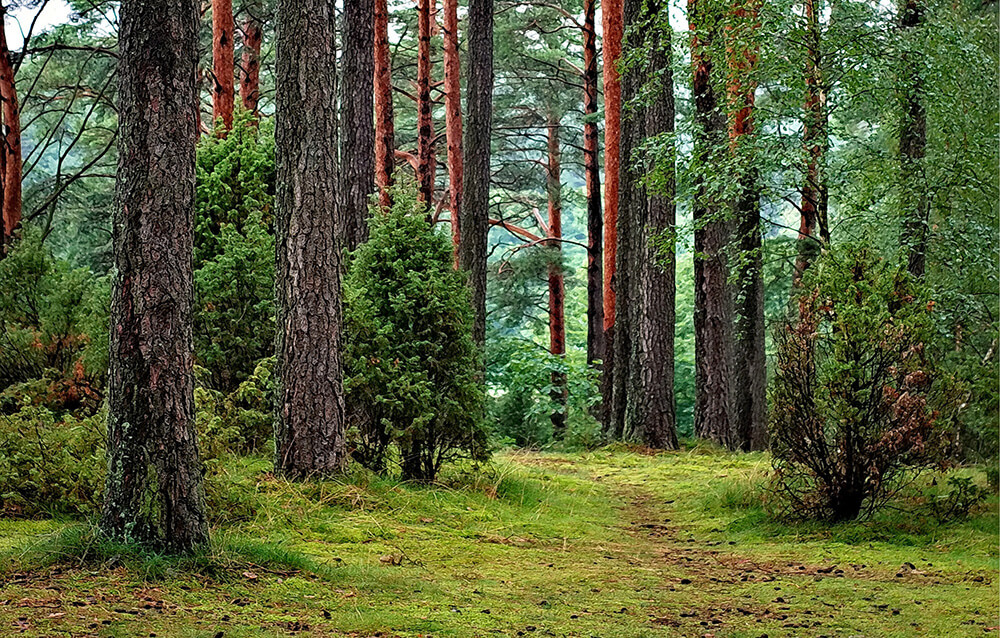Put your trees in perspective: See the forest, too

While many forest landowners and managers are superheroes in their own right, working tirelessly to protect and support healthy forests, a few forest stewards have a special super-power, one that, thankfully, anyone can develop. I call it the “landscape view,” the awareness of how a property fits into our broader landscape.
While your ownership may end at the old stone wall, the landscape extends far beyond these boundaries; while your forest may seem small, it is part of a forested landscape that provides habitat for all our wildlife, cleans the air we all breathe and the water we all drink, sequesters and stores the carbon we all produce and does much more. As a landowner, it is normal to be protective of that tree you love or that special place on your property, but it is also important to use the landscape view to understand how these features are part of something bigger.
The first step in cultivating your landscape view is zooming out from tree-scale to forest-scale. Trees are individually important, but are much more so as part of forests, dynamic systems that grow and change over time. While the death of trees through natural disturbances or harvesting may seem startling or sad, it is a natural and important part of how forests grow and develop—trees die, but the forest lives on. The landscape view allows you to see how seemingly insignificant issues or unpleasant actions on your property—the harvesting of trees and deer, controlling invasive plants—can contribute positively to the broader landscape.
While trees on your property may seem “just fine,” forests across our landscape are recovering from wholesale land clearing for agriculture in the 1800s. This created a forested landscape lacking diversity in composition (number of tree species) and structure (ages and sizes of trees) compared with how pre-settlement forests were likely to have been. Diversity is critical; more-diverse forests will be more resilient to the effects of climate change, feature better wildlife habitat, and sequester and store more carbon than less-diverse forests. Harvesting trees in a thoughtful way can help forests become more diverse while also producing outside benefits: local, renewable resources that decrease our reliance on nonrenewable resources produced under more adverse cultural, social and environmental conditions elsewhere in the country or the world. Periodically generating a little income from sawtimber, firewood and other forest products helps private landowners (who own 80 percent of Vermont’s forests) afford to own land, lowering development pressure and helping forests stay forested.
Use the landscape view to consider harvesting white-tailed deer; deer are over-populated in much of Chittenden County due largely to increases in developed and posted land, in addition to decreasing numbers of hunters. We all love deer, but deer overpopulation is a serious threat to forest health; their browsing damages young trees and plants, lowering diversity and often increasing the abundance of invasive exotic plants. Deer overpopulations can also create problems for the deer themselves, making them smaller, less healthy, and decreasing the quality of their own habitat. I’ve seen serious negative impacts of deer overpopulation on many properties and started recommending harvesting deer, especially antlerless deer, as part of a holistic forest management approach. So, while you may not notice deer or their impacts on your land, allowing hunters to harvest deer from your property is important from a landscape perspective.
Finally, take the landscape view when considering the management of invasive exotic plants. Invasive plants pose a massive threat to forest health, outcompeting native species and diminishing the benefits that healthy forests provide, from wildlife habitat to water quality. They spread across property boundaries with ease, so while your buckthorn infestation may not bother you, it contributes to an extremely serious landscape-level problem. Taking active measures to control these plants, through (on a small scale) cutting or pulling them up or treating them with small amounts of carefully applied herbicide benefits the landscape immensely. You can learn more about invasive plants and their treatment at Vermont Invasives or the Vermont Department of Fish and Wildlife.
With all of these issues, taking the landscape view puts your property in perspective. While your forest may be small, take pride in knowing that it’s part of something far larger and in making the tough choices and putting in the hard work to make it healthy for all of us.
Ethan Tapper is the Chittenden County forester. He can be reached via email, by phone at (802) 585-9099, or at his office at 111 West Street, Essex Junction.

